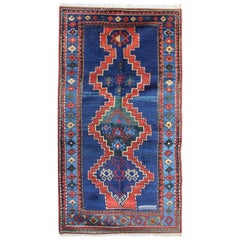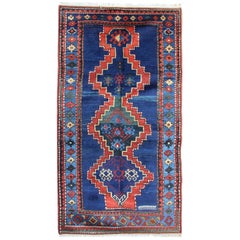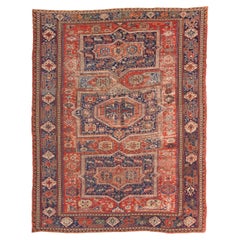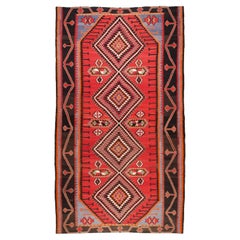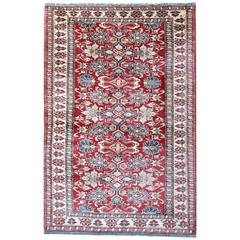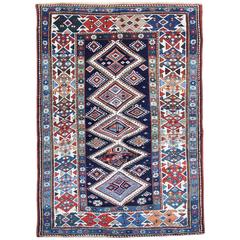Kazak Tribal Art
to
2
2
74
12
10
10
1
1
1
1
1
1
2
2
2
2
2
2
2
2
2
2
Style: Kazak
Antique Rugs Blue Caucasian Kazak Rugs, Geometric Carpet Livingroom Rug
Located in Wembley, GB
Kazak rugs have primarily been produced as village productions rather than city pieces. Made from materials particular to individual tribal provinces and the rugs of the Caucasus typically display bold geometric designs in primary colours. Kazak rugs are a type of Armenian rug...
Category
Late 19th Century Caucasian Antique Kazak Tribal Art
Materials
Natural Fiber, Organic Material, Wool
Antique Rugs Caucasian Kazak Rugs, Blue Geometric Hand made Carpet
Located in Wembley, GB
Kazak rugs have primarily been produced as village productions rather than city pieces. Made from materials particular to individual tribal provinces and the rugs of the Caucasus typ...
Category
Early 20th Century Caucasian Kazak Tribal Art
Materials
Wool, Natural Fiber, Organic Material
Related Items
Antique Caucasus Soumak Kilim Sumac Rug, Caucasian Sumak Natural Carpet
Located in Tokyo, JP
This is an Antique Soumak ( Sumak, Sumac ) Kilim from the Caucasus region with a rare and beautiful color composition.
Of the four countries that make up the Caucasus, Azerbaijan produces the most kilims, and the land has a long history of weaving. The nomadic tribes wove kilims and carpets as well as a wide range of storage bags and sacks, such as saffrash, khurgin and chula, and donkey and horse trappings. Smaller bags for salt, utensils, and other items are also common. Not only are the Azerbaijani weavers prolific, but they also employ many techniques at the loom. These include slitweave- known locally by the word Kilim, warp-faced patterning (jajim), supplementary weft (zili), weft wrapping (popularly known as soumak), and extra weft wrapping (verneh). Furthermore, flatweaves are defined by regional names such as palas and shadda, so it is possible to ascribe a variety of weaving names to particular provenances as follows: soumaks are made in Kuba, palas, and kilims in Hajikabul, zili in Khizy, verneh and zili in Kazakh, shadda, verneh and zili in Barda, jajim in Agjabedi, and palas and kilims in Jabrail.
Soumak weave is a technique in which weft threads are added to a plain weave fabric, and one or two warp threads are wound from the front to the back. The resulting Kilim is denser and firmer, giving it a unique feel and look. This technique is commonly used in the Caucasus region.
Soumak kilims have a very beautiful contrast between orange that shines like the sun, deep purple-tinged indigo, and astringent dark red. You can also see the unevenly dyed abrage in this Soumak, which is like a magic carpet with an oriental atmosphere. Features of the Caucasian Kilim, such as the unique cosmic geometric floral pattern, are also found in this Soumak which has a bright look, but it also has a faded and textured feel, so it can be used in a good old atmosphere.
The woven fabric is particularly solid, so it is recommended for use in a solid living room or under a dining table without moving or twisting. A nice Kilim under a long wooden dining table.
Category
Late 19th Century Caucasian Antique Kazak Tribal Art
Materials
Wool, Natural Fiber
Caucasus Kuba Fine Kilim Vintage Old Rug, Caucasian Natural Carpet
Located in Tokyo, JP
This is a Caucasian Old Kilim from the Kuba region with a red background and beautiful color composition.
Kilim of Kuba, a city in Azerbaijan. It is located by the Caspian Sea, ne...
Category
Mid-20th Century Caucasian Kazak Tribal Art
Materials
Natural Fiber, Wool
$1,560 Sale Price
20% Off
W 74.81 in L 127.96 in
Ararat Rugs Akstafa Kazak Rug - 19th C. Caucasian Revival Carpet Natural Dyed
By Ararat Rugs
Located in Tokyo, JP
Origin and Inspiration:
This stunning revival of the Akstafa Kazak Rug is a modern creation deeply rooted in the rich weaving traditions of the Caucasus, specifically inspired by the...
Category
21st Century and Contemporary Turkish Kazak Tribal Art
Materials
Wool, Natural Fiber, Organic Material
$4,200
W 44.1 in L 72.45 in
Ararat Rugs Derbend Kazak Rug, 19th C. Caucasian Revival Carpet Natural Dyed
By Ararat Rugs
Located in Tokyo, JP
This is a Derbend Kazak rug also known as Daghestan rug, designed late 19th century, is a type of handwoven rug that originates from the Caucasus region, specifically from the town of Derbend (also spelled as Derbent) in modern-day Dagestan, Russia. Derbend rugs have a rich history that dates back centuries and are highly regarded for their intricate designs and craftsmanship. Derbend rugs are known for their bold and vibrant geometric designs. They often feature intricate patterns and motifs such as diamonds, medallions, stars, and stylized floral elements. The designs are typically woven with high contrast, using a variety of colors, including red, blue, green, and ivory. Derbend rugs have been woven by various ethnic groups in the Caucasus region, including the Azerbaijani, Lezgian, and Avar peoples. They hold cultural and historical importance as a form of artistic expression and are considered a part of the region's rich weaving heritage. The design of this rug is interpreted by our designers and soft colors are chosen for this rug.
Color summary: 7 colors in total;
Turquoise 330 (Spurge - Madder Root - Indigo - Walnut Husk)
Dark Brown 316 (No Dye - Sheep’s Own Color)
Barley Corn 103 (Only Specially Washed)
Mandarian Orange 529 (Madder Root - Walnut Hulsk)
Wax Flower...
Category
21st Century and Contemporary Caucasian Kazak Tribal Art
Materials
Wool, Natural Fiber, Organic Material
$2,970
W 51.97 in L 75.6 in
Vintage Old Kuba Super Fine Kilim Rug, Caucasian Carpet
Located in Tokyo, JP
This is a Caucasian Old Kilim from the Kuba (Quba) region in Azerbaijan, with a beautiful color composition.
Kuba is located near Tagestan, north of Azerbaijan, and is beside the Cas...
Category
Early 20th Century Caucasian Kazak Tribal Art
Materials
Wool, Natural Fiber
Antique Caucasian Runner Rug, Caucasus Carpet
Located in Tokyo, JP
This is an antique runner rug from the Caucasus region with a rare and beautiful color composition.
Of all the rugs of the oriental world, it is the work of the Caucasian weavers ...
Category
Early 20th Century Caucasian Kazak Tribal Art
Materials
Wool, Natural Fiber
Antique Caucasus Verneh Kilim Rug, Caucasian Natural Carpet
Located in Tokyo, JP
This is a large Antique Verneh Kilim from the Caucasus region with a rare and beautiful color composition.
Of the four countries that make up the Caucasus, Azerbaijan produces the most kilims, and the land has a long history of weaving. The nomadic tribes wove kilims and carpets as well as a wide range of storage bags and sacks, such as saffrash, khurgin and chula, and donkey and horse trappings. Smaller bags...
Category
Early 20th Century Caucasian Kazak Tribal Art
Materials
Wool, Natural Fiber
Antique Karachov Kazak Rug Karachoph Southwest Caucasus Carpet Late-19th Century
Located in Tokyo, JP
This is an antique Karachov Kazak Rug from the Karachov / Karachoph region, Southwest Caucasus.
The town of Karachov (sometimes rendered Karatchoph o...
Category
Late 19th Century Caucasian Antique Kazak Tribal Art
Materials
Wool, Natural Fiber, Organic Material
$12,000
W 66.93 in L 84.26 in
Caucasia Kuba Kilim Rug, Vintage Old Caucasian Carpet
Located in Tokyo, JP
This is a large, Caucasian Old Kilim from the Kuba region with a red background and beautiful color composition.
This Kilim is from Kuba, a city in Azerbaijan in the Caucasus regi...
Category
Mid-20th Century Caucasian Kazak Tribal Art
Materials
Wool, Natural Fiber
Ararat Rugs Konagkend Kuba Rug, Antique Caucasian Revival Carpet, Natural Dyed
By Ararat Rugs
Located in Tokyo, JP
The source of the rug comes from the book Oriental Rugs Volume 1 Caucasian, Ian Bennett, Oriental Textile Press, Aberdeen 1993, nr.332. This is a sp...
Category
21st Century and Contemporary Turkish Kazak Tribal Art
Materials
Wool, Natural Fiber, Organic Material
$5,800
W 85.83 in L 130.71 in
Old Caucasus Soumak Sumac Kilim Rug, Caucasian Natural Sumak Carpet
Located in Tokyo, JP
This is an old Soumak ( Sumak, Sumac ) Kilim from the Caucasus region with a rare and beautiful color composition.
Of the four countries that make up the Caucasus, Azerbaijan produces the most kilims, and the land has a long history of weaving. The nomadic tribes wove kilims and carpets as well as a wide range of storage bags and sacks, such as saffrash, khurgin and chula, and donkey and horse trappings. Smaller bags for salt, utensils, and other items are also common. Not only are the Azerbaijani weavers prolific, but they also employ many techniques at the loom. These include slitweave- known locally by the word kilim, warp-faced patterning (jajim), supplementary weft (zili), weft wrapping (popularly known as soumak), and extra weft wrapping (verneh). Furthermore, flatweaves are defined by regional names such as palas and shadda, so it is possible to ascribe a variety of weaving names to particular provenances as follows: soumaks are made in Kuba, palas, and kilims in Hajikabul, zili in Khizy, verneh and zili in Kazakh, shadda, verneh and zili in Barda, jajim in Agjabedi, and palas and kilims in Jabrail.
Soumak weave is a technique in which weft threads are added to a plain weave fabric, and one or two warp threads are wound from the front to the back. The resulting kilim is denser and firmer, giving it a unique feel and look. This technique is commonly used in the Caucasus region.
Soumak has a very beautiful contrast between orange that shines like the sun, deep purple-tinged indigo, and astringent dark red. You can also see the unevenly dyed abrage in this Soumak, which is like a magic carpet with an oriental atmosphere. Features of the Caucasian kilim, such as the unique cosmic geometric floral pattern, are also found in this Soumak which has a bright look, but it also has a faded and textured feel, so it can be used in a good old atmosphere.
The woven fabric is particularly solid, so it is recommended for use in a solid living room or under a dining table without moving or twisting. A nice kilim under a long wooden dining table.
Category
Mid-20th Century Caucasian Kazak Tribal Art
Materials
Wool, Natural Fiber
Ararat Rugs Akstafa Kazak Rug, 19th C. Caucasian Revival Carpet Natural Dyed
By Ararat Rugs
Located in Tokyo, JP
The design source of the rug comes from a private collection sold at a European auction. This rug is from the late 19th century, Kazak region, Caucasus area. The Akstafa design remin...
Category
21st Century and Contemporary Caucasian Kazak Tribal Art
Materials
Wool, Natural Fiber, Organic Material
$10,890
W 46.46 in L 105.52 in
Previously Available Items
Kazak Rug
Located in Wembley, GB
This new traditional handwoven rug is featuring designs from the Kazak region. A traditional rug is making the region of the Northern Persia. This rug has made by Afghan weavers of t...
Category
21st Century and Contemporary Caucasian Kazak Tribal Art
Materials
Wool, Cotton
Antique Caucasian Kuba Rug
Located in Wembley, GB
Caucasian rugs are often known for their graphic boldness and color contrast. This graphically sophisticated Kuba presents a highly successful visual alternative to the usual large-s...
Category
1890s Caucasian Antique Kazak Tribal Art
Materials
Wool
Kazak Persian Rug
Located in Wembley, GB
New traditional handwoven Kazak rug with a bold geometric design in red blue and white with a central medallions pattern. Made by hand in wool and cotton.
Category
2010s Afghan Kazak Tribal Art
Materials
Cotton, Wool
Kazak Persian Rug
Located in Wembley, GB
New traditional handwoven Kazak rug handmade in wool and cotton. This striking blue, red, cream and burnt orange Kazak rug depict Classic geometric pattern stars within the border and flowers, birds...
Category
2010s Afghan Kazak Tribal Art
Materials
Cotton, Wool
Kazak Persian Rug
Located in Wembley, GB
This vibrant blue, red, cream and burnt orange handwoven traditional new Kazak rug depict floral, geometric designs Made by hand in wool and cotton.
Category
2010s Afghan Kazak Tribal Art
Materials
Cotton, Wool
Kazak Rugs, Persian Style Rugs, Carpet from Turkey
Located in Wembley, GB
This new traditional woven rug comes in a striking color combination. The tribal rug has bright red, navy, sea blue, cream and caramel colors. This geometric rug has a floral rug des...
Category
2010s Turkish Kazak Tribal Art
Materials
Wool, Cotton, Organic Material
Kazak Rug
Located in Wembley, GB
New traditional handwoven rug featuring designs from the Kazak region. A traditional rug is making a part of the Northern Persia. This rug has made by Afghan weavers of top quality w...
Category
2010s Afghan Kazak Tribal Art
Materials
Cotton, Wool
Kazak Rugs, Persian Style Rugs, Carpet from Afghanistan
Located in Wembley, GB
Kazak luxury rugs are handwoven by the peoples of Armenia and Afghanistan who have influenced by the Caucasian designs of northern Persia. This example features geometric rug pattern...
Category
2010s Afghan Kazak Tribal Art
Materials
Wool, Cotton, Organic Material
Kazak Rug
Located in Wembley, GB
New traditional handwoven rug featuring designs from the Kazak region. A traditional rug is making a part of the northern Persia. This rug has made by Afghan weavers of top quality w...
Category
2010s Afghan Kazak Tribal Art
Materials
Cotton, Wool
Kazak tribal art for sale on 1stDibs.
Find a broad range of unique Kazak tribal art for sale on 1stDibs. Many of these items were first offered in the Early 20th Century, but contemporary artisans have continued to produce works inspired by this style. If you’re looking to add vintage tribal art created in this style to your space, the works available on 1stDibs include folk art, rugs and carpets and other home furnishings, frequently crafted with fabric, natural fiber and other materials. If you’re shopping for used Kazak tribal art made in a specific country, there are Asia, Caucasus, and West Asia pieces for sale on 1stDibs. It’s true that these talented designers have at times inspired knockoffs, but our experienced specialists have partnered with only top vetted sellers to offer authentic pieces that come with a buyer protection guarantee. Prices for tribal art differ depending upon multiple factors, including designer, materials, construction methods, condition and provenance. On 1stDibs, the price for these items starts at $9,870 and tops out at $10,055 while the average work can sell for $9,962.
Recently Viewed
View AllMore Ways To Browse
African Fulani
Antelope Mask
Baoule African
Congo Shield
Congo Spear
Congo Stool
Luba Figure
Nagaland Necklace
Papua New Guinea Shield
Tribal Art Oceania
Wood Antique Butter Churn
Yam Mask
African Baule Mask
African Iron Mask
African Spear Currency
Ancestor Figure Papua New Guinea
Antique Ethiopian Crosses
Brazil Feather Headdress
